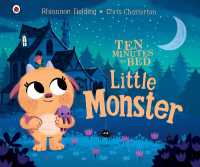Full Description
This book addresses a problem that affects the work of all educators: how traditional methods of assessment undermine the capacity of schools to serve students with diverse cultural and social backgrounds and identities. Anchored in a common-sense notion of validity, this book explains how current K-12 assessment practices are grounded in the language, experiences, and values of the dominant White culture. It presents a timely review of research on bias in classroom and large-scale assessments, as well as research on how students' level of engagement influences their performances. The author recommends practices that can improve the validity of students' assessment performances by minimizing sources of bias, using culturally responsive assessment tools, and adopting strategies likely to increase students' engagement with assessment tasks. This practical resource provides subject-specific approaches for improving the cultural and social relevance of assessment tools and offers guidance for evaluating existing assessment instruments for bias, language complexity, and accessibility issues. Book Features:
Research-based recommendations for improving assessment fairness, validity, and cultural/social relevance.
Practices that have been shown to improve the effectiveness of classroom assessments in supporting student learning.
Concrete examples of how to create culturally relevant assessment tasks that target valued learning goals in language arts, mathematics, social studies, and science classrooms.
Appendixes that provide tools educators can use to improve grading practices.
Contents
Contents
Series Foreword James A. Banks ix
Acknowledgments xv
Introduction 1
Necessary Tensions 5
Layers of Responsibility and Professional Resources for Nondiscrimination 9
Students' Rights to Expression, Privacy, and Association 13
Preparing Teachers and Leaders to Be Advocates 16
1. Background to LGBTQ Movements for Equality With a Focus on K-12-Related Issues 19
Key Definitions, Often in Flux and Contested 22
Opening the Subject of Sexuality and Gender Through Theory, History, and Political Movements 24
Overlapping Histories of LGBTQ Movements 27
Schools and the Histories of Gender Identity and Sexual Orientation 34
2. Thinking Through Biases and Assumptions About LGBTQ People 37
Gender as Process 37
Sexuality, Normalcy, and Intersecting Differences 41
Transphobia in Schools 46
Queer Relationalities 49
3. Specific School-Related Challenges Facing LGBTQ Students 52
Intersecting Harassments and Biases 53
LGBTQ Youth and the Challenges of Accessing Education 56
Resituating "Bullying" in Sexual Harassment 57
Another Form of "Not" Education: "You Can't Say Gay" Policies 60
Recognizing Family Diversity: LGBTQ-Headed Households and School Exclusion 62
Living in Families Under Public Debate: Legal and Social Contexts 64
4. Educatively Addressing LGBTQ Issues 66
Zero Tolerance and Exacerbating Distance 66
Sex and Non-Sex 71
Critical Queer Thinking and Queer Disciplines 73
Religious Tensions 77
Teaching and Learning for Ethical Relations 79
5. Supporting Student Extracurricular and Creative Efforts to Educate Schools on LGBTQ Issues 83
Gay-Straight Alliances/Gender and Sexuality Alliances and Associations Across Difference 83
Gay-Straight Alliances and the Equal Access Act 86
Attempts to Restrict Gay-Straight Alliances 88
The Day of Silence: Resistance and Reconciliation (Hopefully) 90
LGBTQ Youth and Public Spaces 92
6. Recognizing and Respecting Transgender Students 95
Learning About Gender 96
Anti-Transgender Rules From the School Board 100
Administrator Refusal of Family and Physician-Supported Affirmation 101
Watching Teachers Debate Transgender Issues 102
Transgender Students' Resistance and Resourcefulness 104
Intersections and Transgender Theory 107
Conclusion: Unsettled Progress 111
References 113
Index 127
About the Author 137







